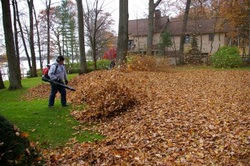
It's that time again in New Hampshire! The snow is melting in Bedford, Amherst, Nashua and all the surrounding towns. What the easiest way to get your Fall Cleanup out of the way? Call us, of course!
If you want to tackle it yourself there are a couple of ways to do it. A rake will make a dent in it but it'll wear you out. The home improvement stores sell lawn vacs. They're nice but pricey. If you have a bagging mower your can mow them up but only if you keep up with them every few days. We use backpack blowers, for the most part. They move a lot of leaves quickly. We put them in piles and suck them up in our trucks. Backpack blowers are easily purchased, and good homeowner models can be purchased for less than 200.00. Buy one and use it year 'round. Blow grass off the driveway after you've cut. Blow powdery snow off the driveway after a light storm. Use it to dry your car off after you wash it. There are many uses for this versatile piece of equipment. Once you've blown the leaves in piles bag them to be recycled at the local recycling center or call us to suck them up. You'll never go wrong buying that blower tho'!
If you want to tackle it yourself there are a couple of ways to do it. A rake will make a dent in it but it'll wear you out. The home improvement stores sell lawn vacs. They're nice but pricey. If you have a bagging mower your can mow them up but only if you keep up with them every few days. We use backpack blowers, for the most part. They move a lot of leaves quickly. We put them in piles and suck them up in our trucks. Backpack blowers are easily purchased, and good homeowner models can be purchased for less than 200.00. Buy one and use it year 'round. Blow grass off the driveway after you've cut. Blow powdery snow off the driveway after a light storm. Use it to dry your car off after you wash it. There are many uses for this versatile piece of equipment. Once you've blown the leaves in piles bag them to be recycled at the local recycling center or call us to suck them up. You'll never go wrong buying that blower tho'!
 RSS Feed
RSS Feed
